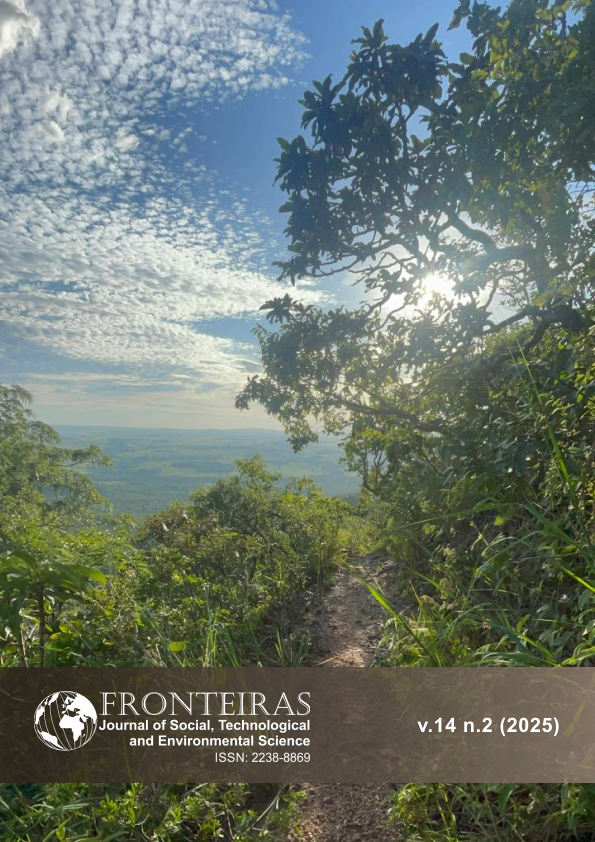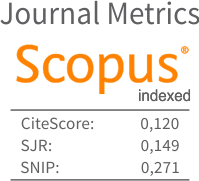Caracterização da Composição Química dos Sedimentos e a Presença de Coliformes Termotolerantes em Diferentes Sub-Bacias Hidrográficas do Rio Grande
DOI:
https://doi.org/10.21664/2238-8869.2025v14i2.p315-329Keywords:
source, sediment, heavy metals, land use and occupationAbstract
Natural and anthropogenic factors influence water and sediment in springs. In rural areas, agricultural and livestock activities affect the dynamics and structure of spring ecosystems. This study aimed to assess differences in the sediment chemical compositions and the presence of thermotolerant coliforms in the water of fifteen springs, in Serrinha region, located in rural landscape of the five Grande River’s sub basins. Concentrations of metals and nutrients were analyzed, along with density estimates of thermotolerant coliforms, to correlate these parameters with land use and occupation. Lead, chromium, nickel, and manganese were not detected in the samples, considering the detection limits of the analytical equipment. Principal component analysis (PCA) indicated that sub-basin 3 had the highest calcium concentrations, while sub-basin 6 exhibited elevated levels of phosphorus, aluminum, and magnesium. Sub-basin 2 had high concentrations of potassium and iron, while sub-basins 1 and 4 showed the highest levels of copper and thermotolerant coliforms, which are probably associated with pasture areas around springs. The coliforms values in these sub-basins suggest a direct influence of livestock activities, emphasizing the need for management practices that prevent the animal waste contact with spring water. The results indicate that the dynamics of chemical elements in sediments are directly related to land use in the region. These findings underscore the importance of adequate preservation of riparian vegetation and controlling diffuse pollution to ensure water resource quality
References
Alvares CA, Stape JL, Sentelhas PC, Gonçalves JLM, Sparovek G 2023. Köppen's climate classification map for Brazil. Meteorologische Zeitschrift 22(6):711-728.
Alves RIS, Sampaio CF, Nadal M, Schuhmacher M, Domingo JL, Segura-Muños SI 2014. Metal concentrations in surface water and sediments from Pardo River, Brazil: human health risks. Environmental Research 133:149-155.
Anyanwu ED, Onyele OG 2018. Occurrence and concentration of heavy metals in a rural spring in South-Eastern Nigeria. Journal of Applied Sciences and Environmental Management 22:1473–1478.
Botrel N, Freitas S, Fonseca MJO, Melo RAC, Madeira N 2020. Valor nutricional de hortaliças folhosas não convencionais cultivadas no Bioma Cerrado. Brazilian Journal of Food Technology 23:e2018174.
Brasil. Conselho Nacional de Meio Ambiente - CONAMA. Resolução nº 357, de 17 de março de 2005. Dispõe sobre a classificação das águas doces, salinas e salobras do território nacional e estabelece as condições e padrões de lançamento de efluentes. Diário Oficial da União, 17 de março de 2005.
Brasil. Lei no 12.651, de 25 de maio de 2012. Dispõe sobre a proteção da vegetação nativa; altera as Leis no 6.938, de 31 de agosto de 1981, 9.393, de 19 de dezembro de 1996, e 11.428, de 22 de dezembro de 2006; revoga as Leis no 4.771, de 15 de setembro de 1965, e 7.754, de 14 de abril de 1989, e a Medida Provisória no 2.166-67, de 24 de agosto de 2001; e dá outras providências. Disponível em: http://www.planalto.gov.br/ccivil_03/_ato2011-2014/2012/lei/L12651compilado.htm. Acesso em: 03 mai 2024.
Brasil. Ministério do Meio Ambiente (MMA). Águas subterrâneas: um recurso a ser conhecido e protegido. Secretaria de Recursos Hídricos e Ambiente Urbano. Brasília, DF: MMA, 2007.
Brito LM, Santos ECL, Silva ALS, López AMQ, Silva ACC, Melo JG 2024. Qualidade físico-química e microbiológica da água de nascentes da bacia hidrográfica do Rio Coruripe, Alagoas-Brasil. Interfaces Científicas – Saúde e Ambiente 9(3):53-67.
Carvalho EMD, Uieda VS 2004. Colonização por macroinvertebrados bentônicos em substrato artificial e natural em um riacho da serra de Itatinga, São Paulo, Brasil. Revista Brasileira de Zoologia 21:287-293.
Cloud Software Group, INC. Statistica. Data Science Workbench, version 14. 2023 http://tibco.com.
CPRM - COMPANHIA DE PESQUISA DE RECURSOS MINERAIS. Projeto Rede Integrada de Monitoramento das Águas Subterrâneas: relatório diagnóstico Sistema Aquífero Bauru–Caiuá no Estado de Minas Gerais. Belo Horizonte/MG, CPRM – Serviço Geológico do Brasil. 2012.
Souza CLF, Oliveira RB, Mustafé DN, Nunes KAC, Morais EMB 2019. O cerrado como o “berço das águas”: potencialidades para a educação geográfica. Revista Cerrados (Unimontes) 17(1):86-113.
Embrapa. Manual de Métodos de Análise de Solo. 3. ed. Brasília: Embrapa, 2017.
Felfili JM, Sousa-Silva JC, Scariot A 2005. Biodiversidade, ecologia e conservação do cerrado: avanços no conhecimento. In Scariot A., Sousa-Silva JC, Felfili JM. Cerrado: ecologia, biodiversidade e conservação. Ministério do Meio Ambiente, Brasília. p. 61-72.
Garcia CAB, Santos MS, Bellin IC, Santos EAO, Costa SSL, Garcia HL 2022. Determinação de metais em alimentos vegetais produzidos nos perímetros irrigados Jacarecica I e Açude Macela em Sergipe. Research, Society and Development 11(16):e559111638736.
Haridasan M 2008. Nutritional adaptations of native plants of the cerrado biome in acid soils. Journal of Plant Physiology 20(3): 183-195.
IBGE – INSTITUTO BRASILEIRO DE GEOGRAFIA E ESTATÍSTICA. IBGE Cidades: Frutal. 2023. Disponível em: https://cidades.ibge.gov.br/brasil/mg/frutal/pesquisa/14/10193?ano=2022. Acesso em: 27 nov. 2023.
IDEXX. Laboratories, Inc., One IDEXX Drive, Westbrook, Maine 04092 USA idexx.com/water. 2017. Disponível em: https://www.idexx.es/files/colilert-procedure-en.pdf.
Legendre P, Legendre L. Numerical ecology. 3. Ed, Amsterdam, Elsevier Science, 2012.
MAPBIOMAS. Projeto MapBiomas – Coleção 3.1 da Série Anual de Mapas de Cobertura e Uso da Terra no Brasil.
Medeiro MLS, Demartelaere ACF, Pereira MD, Pádua GVG 2019. Adequação do teste de lixiviação de potássio em sementes de Moringa oleifera. Ciência Florestal 29(2):941-949.
Mehlich A. Determination of P, Ca, Mg, K, Na and NH4. Raleigh, North Carolina Soil Testing Division, 1953. 195 p.
Moraes RA 2020. Análise das mudanças do uso e da cobertura da terra em municípios com áreas de mineração na microrregião de Itabira, a partir de dados do MAPBIOMAS entre 1987 e 2017. Revista Engenharia de Interesse Social 5(6):77-96.
Moreira EA, Souza TS, Domingo SS, Siqueira APS 2019. Protocolo de recuperação de nascentes no bioma cerrado. Informe Goiano 7(4): 1-4.
Moreira GN, Biscalquini AC, Gonçalves IAV, Silva ER, Senhuk APMS, Anhê ACBM 2024. Uso de macroinvertebrados bentônicos para análise integrada da sub-bacia do Ribeirão Conquitinha, afluente do Rio Grande (MG, Brasil). Scientia Plena 20(2):022401.
Nascimento DTF, Novais GT 2020. Clima do Cerrado: dinâmica atmosférica e características, variabilidades e tipologias climáticas. Élisée - Revista de Geografia da UEG 9(2):922021.
Nascimento DBD, Lopes MLS, Izidro JLPS, Bezerra RCA, Gois GC, Amaral TNE, Dias WS, Barros MML, Oliveira ARS, Farias-Sobrinho JL, Coêlho JJ 2024. Ciclagem de nitrogênio, fósforo e potássio em ecossistemas de pastagem. Ciência Animal Brasileira, 25:e-76743.
Novais GT 2019. Classificação climática aplicada ao Bioma Cerrado. Tese de Doutorado, Universidade Federal de Uberlândia, Instituto de Geografia, 184pp.
Owens P 2008. Sediment Management at the River Basin Scale. In: Sustainable Management of Sediment Resources. Vol. 4, Elsevier Science, UK, 280 pp.
Paula-Filho FJ, Marins RV, Lacerda LD, Aguiar JE, Peres TF 2015. Background values for evaluation of heavy metal contamination in sediments in the Parnaíba River Delta estuary, NE/Brazil. Marine Pollution Bulletin, 91:424-428.
Pinto MN, Lira RA, Meira-Neto JÁ 2020. Ecologia funcional: Relação do gradiente pedológico e abundância de espécies lenhosas do Cerrado Brasileiro. Biota Amazônia 10(1):6-10.
Reis LBS, Mesquita MN, De-Carvalho PS, Miranda SC 2022. Atributos funcionais de espécies vegetais do Cerrado–importância, aspectos metodológicos e ecológicos. Enciclopédia Biosfera 19(40):76-92.
Santos EO, Schwantz PI, Bohrer REG, Prestes MMB, Lara DM, 2021. Análise ambiental de nascentes do bairro Fontes no município de Soledade (RS), Brasil. Revista em Agronegócio e Meio Ambiente 14:2e8771.
Silva SC, Medeiros LS, Neto, MFB, Silva MJ, Ramos, TPA, Lima FCT, Lima SMQ 2023. Ichthyofauna of the Nascentes do Rio Parnaíba National Park: watershed divide in the main agricultural encroachment area in the Brazilian Cerrado. Biota Neotropica 23(1):e20221414.
Downloads
Published
How to Cite
Issue
Section
License
Copyright (c) 2025 Lelisberto Baldo Vieira, Eliana Aparecida Panarelli, Daniela Fernanda da Silva Fuzzo, Rodrigo Ney Millan

This work is licensed under a Creative Commons Attribution-NonCommercial 4.0 International License.
This journal offers immediate free access to its content, following the principle that providing free scientific knowledge to the public, we provides greater global democratization of knowledge.
As of the publication in the journal the authors have copyright and publication rights of their articles without restrictions.
The Revista Fronteiras: Journal of Social, Technological and Environmental Science follows the legal precepts of the Creative Commons - Attribution-NonCommercial-ShareAlike 4.0 International. 


